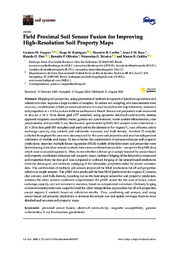Field proximal soil sensor fusion for improving high-resolution soil property maps.
Field proximal soil sensor fusion for improving high-resolution soil property maps.
Author(s): VASQUES, G. de M.; RODRIGUES, H. M.; COELHO, M. R.; BACA, J. F. M.; DART, R. de O.; OLIVEIRA, R. P. de; TEIXEIRA, W. G.; CEDDIA, M. B.
Summary: Mapping soil properties, using geostatistical methods in support of precision agriculture and related activities, requires a large number of samples. To reduce soil sampling and measurement time and cost, a combination of field proximal soil sensors was used to predict and map laboratory-measured soil properties in a 3.4-ha pasture field in southeastern Brazil. Sensor soil properties were measured in situ on a 10 × 10-m dense grid (377 samples) using apparent electrical conductivity meters, apparent magnetic susceptibility meter, gamma-ray spectrometer, water content reflectometer, cone penetrometer, and portable X-ray fluorescence spectrometer (pXRF). Soil samples were collected on a 20 × 20-m thin grid (105 samples) and analyzed in the laboratory for organic C, sum of bases, cation exchange capacity, clay content, soil volumetric moisture, and bulk density. Another 25 samples collected throughout the area were also analyzed for the same soil properties and used for independent validation of models and maps. To test whether the combination of sensors enhances soil property predictions, stepwise multiple linear regression (MLR) models of the laboratory soil properties were derived using individual sensor covariate data versus combined sensor data-except for the pXRF data, which were evaluated separately. Then, to test whether a denser grid sample boosted by sensor-based soil property predictions enhances soil property maps, ordinary kriging of the laboratory-measured soil properties from the thin grid was compared to ordinary kriging of the sensor-based predictions from the dense grid, and ordinary cokriging of the laboratory properties aided by sensor covariate data. The combination of multiple soil sensors improved the MLR predictions for all soil properties relative to single sensors. The pXRF data produced the best MLR predictions for organic C content, clay content, and bulk density, standing out as the best single sensor for soil property prediction, whereas the other sensors combined outperformed the pXRF sensor for the sum of bases, cation exchange capacity, and soil volumetric moisture, based on independent validation. Ordinary kriging of sensor-based predictions outperformed the other interpolation approaches for all soil properties, except organic C content, based on validation results. Thus, combining soil sensors, and using sensor-based soil property predictions to increase the sample size and spatial coverage, leads to more detailed and accurate soil property maps.
Publication year: 2020
Types of publication: Journal article
Unit: Embrapa Soils
Observation
Some of Embrapa's publications are published as ePub files. To read them, use or download one of the following free software options to your computer or mobile device. Android: Google Play Books; IOS: iBooks; Windows and Linux: Calibre.
Access other publications
Access the Agricultural Research Database (BDPA) to consult Embrapa's full library collection and records.
Visit Embrapa Bookstore to purchase books and other publications sold by Embrapa.

